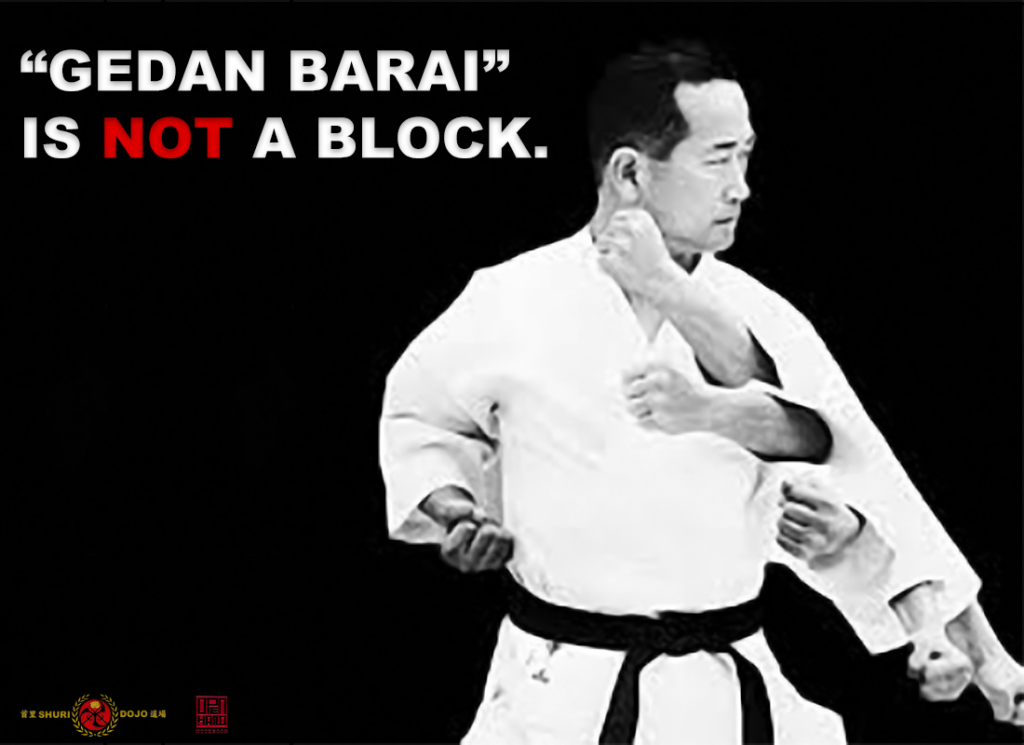The modern labels attached to many karate techniques may have little to do with their intended function. These labels arose relatively recently in karate’s development and originate from the „watered down“ karate taught in Okinawan schools, in the early part of the 20th century, modernized further on the mainland of Japan. Prior to this time, there was no consistent terminology in use.
.
It is my opinion that you have to study in the correct context. Practitioners of the martial arts really need to understand the difference between karate for sport, karate for children, dojo sparring/fighting, and pragmatic self-defense orientated karate.
.
The applications that anyone uses in their karate is just a reflection of their own knowledge. If all they have is an understanding of punching, kicking, and blocking, then that’s what they’re going to see in the techniques and movements within the kata.
.
So let’s look at one very common technique which is most often taught as a “lower block”, otherwise known as “gedan barai” (sometimes gedan barai uke). By now most people understand the meaning of the word “uke” does not translate to “block”.
.
If the ”lower-block“ was never meant to be applied as a block, then what is it? The “gedan barai” (I will refrain from calling it a lower-block) has many different functions and it depends upon the kata in question and the surrounding movements.
.

Not all “gedan barai” are performed in exactly the same way. The motion could be slightly different depending upon the function, and from the number of “gedan barai” in kata, we can determine that the ‘motion’ must have many functions, otherwise it wouldn’t be shown so many times.
.
There are many reasons why “gedan barai” should not be applied as a block. A highly important consideration is that when this movement is used as a block you’ve done nothing to disadvantage an attacker. It should always be remembered that every single kata motion must, as an absolute minimum, disadvantage the attacker and leave the practitioner in a position of significant advantage.
.
Discard for a moment the idea that you are ‘blocking’ and see what happens.
.
Remove the distance, move into grappling range, don’t have a ‘dead hand’ (utilize both hands), then have a look at what is presented to you. Suddenly your “chambered” hand on your hip has another function, your stance makes more sense, your body position has become more advantageous, an angle gained, there are numerous ways that suddenly the movement works to your benefit.
.
It is important to remember that karate is not, or at least was not, originally a long range art. It was created as a close-range defensive method which contains throws, take-down defenses, sweeps, chokes, and joint locks.
.
It’s quite common for kata movements to be incorrectly interpreted so that no advantage is gained and the practitioner is left in a „neutral“ guard position allowing an attacker another chance to attack….. Not a good idea!
.
The original karate from Okinawa was an art very much focused on close-quarter combat. It is not surprising then, that a fundamental technique, now called “gedan barai”, transitions directly into limb control, takedowns and control of an attacker.
.
Look a the ‘movement’ in its entirety, from beginning to the end, and decide for yourself.![]()
![]()
.
.
With thanks to Iain Abernethy and Shuri Karate Dojo